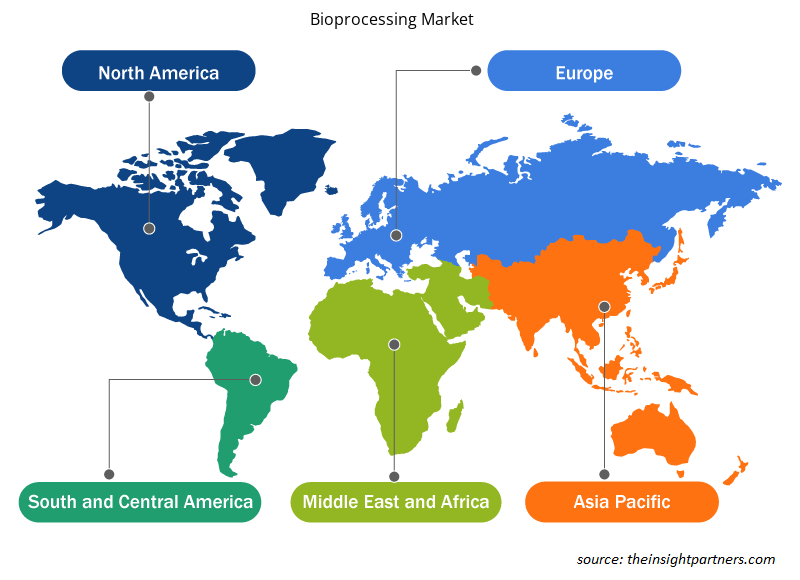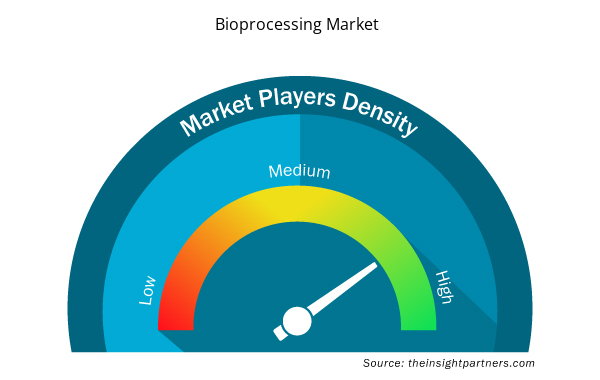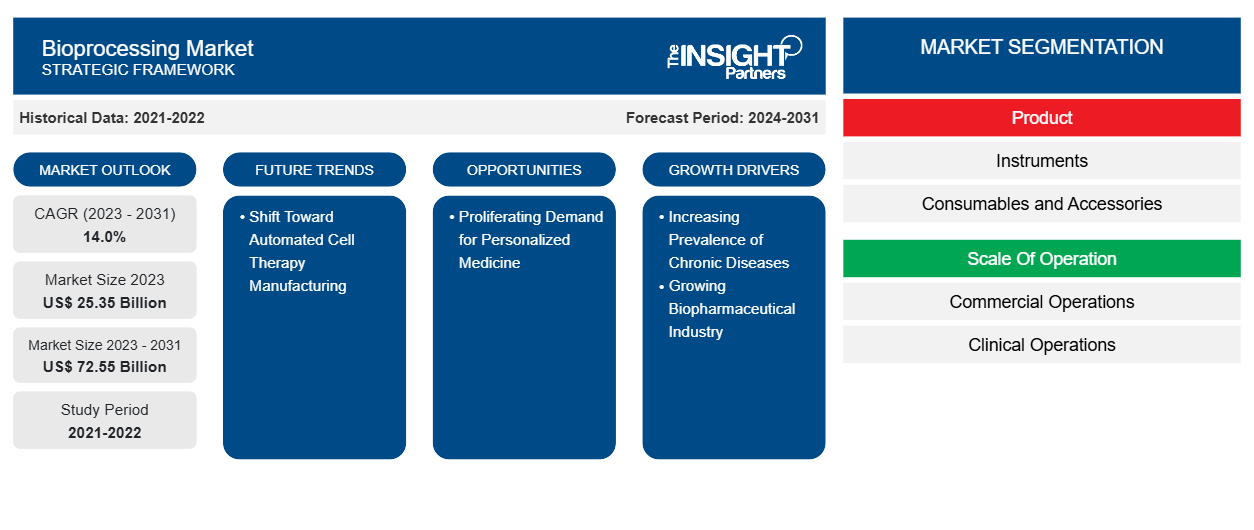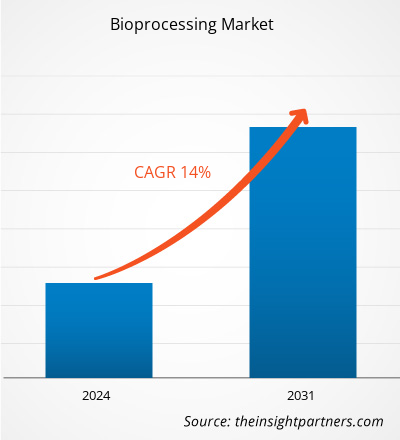生物加工市场规模预计将从 2023 年的 253.5 亿美元飙升至 2031 年的 725.5 亿美元;预计 2023-2031 年期间的复合年增长率为 14.0%。
分析师观点:
该报告包括当前生物加工市场趋势及其在预测期内可预见的影响所带来的增长前景。慢性病病例的增加是增加对新药需求的主要因素之一,从而产生了对生物加工的需求。此外,对癌症等疾病的个性化治疗增加了对各种生物加工技术(包括细胞疗法)的需求。近年来,生命科学行业研发的重要性得到了极大的提升。由于这一趋势,政府对制药和生物技术行业的支持也在增加。此外,对预防措施和特定应用的替代药物的日益关注推动了生物加工市场的发展。此外,增加对新技术的投资以克服与制造生物加工产品相关的性能和质量问题预计将推动生物加工市场的增长。
市场概况:
高度专注于生物制剂的生物制药行业的扩张导致对研究服务的需求比以前更高。行业参与者和学术机构之间合作的增加促进了资源共享和生物加工的加速。生物工艺技术研发资金的增加预计将推动全球生物加工市场的增长。此外,各国政府对生物燃料生产的支持增加预计将推动生物工艺技术市场的增长。由于癌症等传染病和慢性病数量的增加,预计生物制药行业对生物加工的需求将大幅增加。生物制药行业的发展、研发支出的增加、疫苗生产的升级和技术进步可能会对未来几年的生物加工市场预测产生重大影响。然而,严格的监管准则和高昂的技术成本阻碍了生物工艺技术的发展。
定制此报告以满足您的需求
您可以免费定制任何报告,包括本报告的部分内容、国家级分析、Excel 数据包,以及为初创企业和大学提供优惠和折扣
- 获取此报告的关键市场趋势。这个免费样品将包括数据分析,从市场趋势到估计和预测。
市场驱动因素:
慢性病患病率上升推动市场增长
老年人久坐不动的生活导致肥胖和糖尿病等生活方式疾病的患病率上升。遗传基因还可能导致这些疾病以及其他健康问题,如心血管疾病 (CVD)、阿尔茨海默病和抑郁症。根据美国国家老龄委员会的数据,80% 的成年人(65 岁及以上)一生中至少患有一种慢性疾病。根据美国疾病控制和预防中心 (CDC) 的数据,2020 年,美国约有 60% 的人患有至少一种严重疾病,40% 的人患有两种或两种以上的慢性疾病。
心血管疾病(例如心绞痛、动脉粥样硬化和因忙碌的生活方式引起的急性心肌梗塞)是全球死亡的主要原因之一。根据世界心脏基金会的数据,过去 30 年(1990-2020 年)因心血管疾病导致的死亡率飙升了 60%。2021 年,因心血管疾病死亡的人数为 2050 万。糖尿病是一种危及生命的慢性疾病,目前尚无治愈方法。根据国际糖尿病联合会的数据,北美糖尿病病例数预计将从 2017 年的 4600 万增加到 2045 年的 6200 万。根据全球癌症观察站 (GLOBOCAN) 2020 年发布的估计,全球报告了 1930 万例癌症病例。美国、中国和印度的病例数显著增加。 GLOBOCAN 进一步估计,到 2040 年,印度的癌症病例将达到约 208 万,比 2020 年增长 57.5%。同样,根据世界卫生组织 2022 年 2 月发布的数据,全球约有 1000 万人死于癌症。癌症发病率的激增表明需要创新的癌症治疗方法。单克隆抗体是一类有前途的靶向抗癌剂,可增强免疫系统抑制癌细胞活性和消除癌细胞的自然能力。抗体-药物偶联物 (ADC) 在癌症治疗中也显示出有希望的结果。
专家、患者、初级保健医生和其他医疗保健专业人员认识到生物仿制药的高效性和安全性,这推动了其需求。事实证明,生物仿制药可以改善数百万患者的生活质量。它们是治疗许多疾病的有效且具有成本效益的选择,包括慢性皮肤病(如牛皮癣和特应性皮炎)、肠道疾病(如克罗恩病、肠易激综合征和结肠炎)、糖尿病、自身免疫性疾病、癌症、肾脏疾病和关节炎。生物仿制药开发商正在采用先进的生物加工技术来降低制造成本,这是决定最终消费者价格的重要因素。几乎所有的生物仿制药开发商都在使用现代的尖端生物加工技术。因此,随着慢性病的日益流行,对治疗危及生命的疾病的生物仿制药的需求正在激增,从而推动了对生物加工的需求,导致生物加工市场增长。
节段分析:
生物加工市场分析考虑了以下几个部分:产品、运营规模、流程、应用和最终用户。
根据产品,生物加工市场分为仪器、耗材和配件。仪器部分在 2023 年占据了较大的市场份额,并且可能在 2023-2031 年期间实现最高的 14.5% 复合年增长率。
根据运营规模,市场分为商业运营和临床运营。商业运营部门在 2023 年占据了更大的生物加工市场份额,预计在预测期内将实现更高的复合年增长率。
根据工艺,生物加工市场分为下游生物加工和上游生物加工。下游生物加工部分在 2023 年占据了更大的市场份额,预计在 2023-2031 年期间的复合年增长率将达到 14.4%。下游生物加工是回收、浓缩和纯化上游生物产品以满足质量要求的阶段。下游生物加工适用于单克隆抗体或蛋白质的纯化以及寡核苷酸、多糖和各种疫苗的制造。与下游生物加工相关的步骤包括收获和过滤、捕获、超滤、纯化、生物结合和配制。
根据应用,生物加工市场分为单克隆抗体、疫苗、重组蛋白、细胞和基因治疗等。单克隆抗体部分在 2023 年占据了市场份额的主导地位。预计细胞和基因治疗部分在预测期内的复合年增长率最高,为 16.5%。细胞和基因治疗是生物医学治疗和研究中的重叠领域。两种疗法都旨在预防、治疗或潜在治愈疾病。此外,细胞疗法和基因疗法都有可能缓解遗传和后天疾病的根本原因。细胞疗法旨在通过在注射到患者体内之前恢复或修改体外的几组细胞或使用细胞在体内进行治疗来治疗疾病。基因疗法旨在通过恢复或将新基因引入细胞来治疗疾病——无论是在体外(离体)还是在体内(体内)。
根据最终用户,生物加工市场分为生物制药公司、合同制造组织和其他。生物制药公司部门在 2023 年占据了最大的生物加工市场份额;合同制造组织部门预计在 2023-2031 年期间的复合年增长率最高,为 14.7%。全球生物制药公司的数量正在增加,导致公司之间有大量的合作和协议。公司在药物和其他生物仿制药研发方面的投资有所增加。生物技术的进步提高了对药物可能靶点的识别能力。生物加工在癌症治疗中的应用日益广泛,生物制药治疗无法治愈的疾病的能力预计将加速市场增长。
区域分析:
生物加工市场报告的范围包括北美、欧洲、亚太地区、中东和非洲以及南美和中美。北美市场在 2023 年的价值为 124.4 亿美元,预计到 2030 年将达到 359.5 亿美元;预计在 2023-2031 年期间的复合年增长率为 14.2%。该地区的市场增长归因于罕见病发病率的增加以及细胞和基因治疗 (CGT) 的上升趋势。遗传和细胞疾病发病率的增加导致对细胞疗法的需求增加。2023 年 4 月,Cytiva 推出了 X-platform 生物反应器,以使用一次性产品简化上游生物加工操作。美国生物制药和生物技术公司不断增加研发投资,以改善临床试验结果并确保患者安全,以及美国政府不断增加的投资对精准医疗的日益关注,促进了美国生物加工市场的增长。预计亚太地区在 2023-2031 年期间的复合年增长率最高,为 15.1%。亚太生物加工市场分为中国、日本、印度、韩国、澳大利亚和亚太其他地区。中国在 2023 年占据了最大的市场份额,预计印度将在市场上显示出显着的增长率。中国的生物制药行业正在经历巨大的转变,从以仿制药为中心的格局发展成为一个蓬勃发展的创新中心。印度的生物加工能力高度依赖于其合格的劳动力和成本效率,这为市场创造了增长机会。印度企业如 Piramal Enterprises Ltd. 和 Aurigene Pharmaceutical Services Ltd. 是全球生物制药公司,提供抗体发现和工程、连接体-有效载荷化学、结合和表征等解决方案和服务以开发药物。这些公司在该国的存在对市场增长做出了重大贡献。
关键球员分析:
Cytiva(丹纳赫集团)、Sartorius AG、赛默飞世尔科技公司、Repligen Corporation、Merck KgaA、3M Company、Getinge AB、Eppendorf SE、康宁公司、Entegris、安捷伦科技公司和Bio-Rad Laboratories 是生物加工市场报告中介绍的主要参与者。
生物加工市场区域洞察
Insight Partners 的分析师已详尽解释了预测期内影响生物加工市场的区域趋势和因素。本节还讨论了北美、欧洲、亚太地区、中东和非洲以及南美和中美洲的生物加工市场细分和地理位置。

- 获取生物加工市场的区域特定数据
生物加工市场报告范围
| 报告属性 | 细节 |
|---|---|
| 2023 年的市场规模 | 253.5亿美元 |
| 2031 年市场规模 | 725.5亿美元 |
| 全球复合年增长率(2023 - 2031) | 14.0% |
| 史料 | 2021-2022 |
| 预测期 | 2024-2031 |
| 涵盖的领域 | 按产品
|
| 覆盖地区和国家 | 北美
|
| 市场领导者和主要公司简介 |
|
生物加工市场参与者密度:了解其对业务动态的影响
生物加工市场正在快速增长,这得益于终端用户需求的不断增长,而这些需求又源于消费者偏好的不断变化、技术进步以及对产品优势的认识不断提高等因素。随着需求的增加,企业正在扩大其产品范围,进行创新以满足消费者的需求,并利用新兴趋势,从而进一步推动市场增长。
市场参与者密度是指在特定市场或行业内运营的企业或公司的分布情况。它表明在给定市场空间中,相对于其规模或总市场价值,有多少竞争对手(市场参与者)存在。
在生物加工市场运营的主要公司有:
- Getinge 公司,
- 赛默飞世尔科技公司,
- 赛多利斯公司,
- 康宁公司
- Bio-Rad 实验室公司
- 默克公司,
免责声明:上面列出的公司没有按照任何特定顺序排列。

- 了解生物加工市场顶级关键参与者概况
最新动态:
在生物加工市场运营的公司采取了并购和合作等战略举措。根据公司新闻稿,以下列出了一些最近的市场发展情况:
- 2024 年 2 月,Cytiva 与 LevitasBio 合作,为学术界和工业界的基因组学研究人员提供创新的单细胞工作流程。此次合作标志着改进样品制备方式的重要里程碑,使研究人员能够快速执行分解组织和纯化单个细胞悬浮液等任务,以进行单细胞分析和其他下游应用。这对于推进个性化医疗尤为重要,因为它可以深入了解疾病机制和治疗目标,支持肿瘤学研究,并加速科学发现。
- 2024 年 2 月,赛默飞世尔科技公司宣布扩建其位于圣路易斯的制造工厂,该工厂将支持生产罕见疾病的生物疗法。通过此次扩建,该公司将其用于复杂生物治疗的生物制剂生产能力提高了一倍,计划将用于治疗癌症、自身免疫性疾病和罕见疾病等疾病的产量从 2,000 升提高到 5,000 升。扩建后的工厂总面积为 33,000 平方英尺(3,065 平方米),配备了四个 Thermo Scientific DynaDrive 一次性生物反应器,每个反应器的处理能力高达 5,000 升。
- 2024 年 1 月,安捷伦科技公司宣布与 Incyte 达成协议,整合安捷伦在开发伴随诊断 (CDx) 方面的专业知识和成功经验,以支持 Incyte 血液学和肿瘤学产品组合的开发和商业化。
- 2023 年 11 月,Cytiva 推出了创新的 Cytiva Protein Select 技术,旨在简化和加速重组蛋白纯化。自切割无痕标签和互补亲和层析树脂使任何蛋白质的纯化标准化,无需为每种蛋白质使用特定的亲和结合伙伴。蛋白质纯化是基础研究、药物发现、工艺开发和生物加工不可或缺的一部分。
- 历史分析(2 年)、基准年、预测(7 年)及复合年增长率
- PEST 和 SWOT 分析
- 市场规模价值/数量 - 全球、区域、国家
- 行业和竞争格局
- Excel 数据集



Report Coverage
Revenue forecast, Company Analysis, Industry landscape, Growth factors, and Trends

Segment Covered
This text is related
to segments covered.

Regional Scope
North America, Europe, Asia Pacific, Middle East & Africa, South & Central America

Country Scope
This text is related
to country scope.
常见问题
Bioprocessing increases the number of living cells or other biological systems/components (such as bacteria, enzymes, proteins, viruses, or nucleic acids) in a commercial bioreactor for biopharmaceutical manufacturing. Products produced in the bioprocessing sector typically contain high-quality therapeutics and vaccines critical to modern healthcare advancement. The current bioprocessing industry landscape is characterized by dynamic developments driven by advances in biotechnology and increasing demand for biopharmaceuticals. The increase in demand is attributed to the prevalence of chronic diseases, the growing adoption of personalized medicine, and increasing bioprocessing applications in various sectors. As bioprocessing becomes significantly important in producing therapeutic proteins, vaccines, and other bio-based products, it turns out to be a key enabler of the biotechnological revolution. The market is progressing toward meeting the demands of a changing healthcare landscape, and the need for efficient and scalable bioproduction processes is expected to bring new bioprocessing market trends in the coming years.
Key factors that are driving increasing prevalence of chronic diseases and the growing biopharmaceutical industry.
The instruments segment held the largest share of the market in the global bioprocessing market and held the largest market share of 67.3% in 2023.
The CAGR value of the bioprocessing market during the forecasted period of 2023-2031 is 14.0%.
The downstream bioprocess segment dominated the global bioprocessing market and held the largest market share of 68.8% in 2023.
The bioprocessing market majorly consists of the players such Cytiva (Danaher Corporation), Sartorius AG, Thermo Fisher Scientific Inc., Repligen Corporation, Merck KgaA, 3M Company, Getinge AB, Eppendorf SE, Corning Incorporated, Entegris, Agilent Technologies, and Bio-Rad Laboratories.
Global bioprocessing market is segmented by region into North America, Europe, Asia Pacific, Middle East & Africa, and South & Central America. The North America regional market is expected to grow with a CAGR of 14.2% during 2023–2031. Market growth in this region is attributed to the increasing incidence of rare diseases and the rising trend of cell and gene therapy (CGT) in the region. The US held the largest market share in 2023 in North America. The growth of the biopharmaceutical sector, mainly due to technological advancements, increasing flexibility, and low operational costs, also benefits the bioprocessing market in the US. As per the International Trade Administration (ITA), the US is the largest market for biopharmaceuticals and the global leader in R&D. According to the PhRMA, companies in the US account for nearly 50% of the global biopharmaceutical R&D work, and they have succeeded in developing many novel medicines for which they hold intellectual property rights. However, Asia Pacific is expected to grow at a fastest CAGR during 2023–2031.
Sartorius AG and Eppendorf SE are the top two companies that hold huge market shares in the bioprocessing market.
Trends and growth analysis reports related to Life Sciences : READ MORE..
The List of Companies - Bioprocessing Market
- Cytiva (Danaher Corporation)
- Sartorius AG
- Thermo Fisher Scientific Inc.
- Repligen Corporation
- Merck KgaA
- 3M Company
- Getinge AB
- Eppendorf SE
- Corning Incorporated
- Entegris
- Agilent Technologies
- Bio-Rad Laboratories
The Insight Partners performs research in 4 major stages: Data Collection & Secondary Research, Primary Research, Data Analysis and Data Triangulation & Final Review.
- Data Collection and Secondary Research:
As a market research and consulting firm operating from a decade, we have published and advised several client across the globe. First step for any study will start with an assessment of currently available data and insights from existing reports. Further, historical and current market information is collected from Investor Presentations, Annual Reports, SEC Filings, etc., and other information related to company’s performance and market positioning are gathered from Paid Databases (Factiva, Hoovers, and Reuters) and various other publications available in public domain.
Several associations trade associates, technical forums, institutes, societies and organization are accessed to gain technical as well as market related insights through their publications such as research papers, blogs and press releases related to the studies are referred to get cues about the market. Further, white papers, journals, magazines, and other news articles published in last 3 years are scrutinized and analyzed to understand the current market trends.
- Primary Research:
The primarily interview analysis comprise of data obtained from industry participants interview and answers to survey questions gathered by in-house primary team.
For primary research, interviews are conducted with industry experts/CEOs/Marketing Managers/VPs/Subject Matter Experts from both demand and supply side to get a 360-degree view of the market. The primary team conducts several interviews based on the complexity of the markets to understand the various market trends and dynamics which makes research more credible and precise.
A typical research interview fulfils the following functions:
- Provides first-hand information on the market size, market trends, growth trends, competitive landscape, and outlook
- Validates and strengthens in-house secondary research findings
- Develops the analysis team’s expertise and market understanding
Primary research involves email interactions and telephone interviews for each market, category, segment, and sub-segment across geographies. The participants who typically take part in such a process include, but are not limited to:
- Industry participants: VPs, business development managers, market intelligence managers and national sales managers
- Outside experts: Valuation experts, research analysts and key opinion leaders specializing in the electronics and semiconductor industry.
Below is the breakup of our primary respondents by company, designation, and region:

Once we receive the confirmation from primary research sources or primary respondents, we finalize the base year market estimation and forecast the data as per the macroeconomic and microeconomic factors assessed during data collection.
- Data Analysis:
Once data is validated through both secondary as well as primary respondents, we finalize the market estimations by hypothesis formulation and factor analysis at regional and country level.
- Macro-Economic Factor Analysis:
We analyse macroeconomic indicators such the gross domestic product (GDP), increase in the demand for goods and services across industries, technological advancement, regional economic growth, governmental policies, the influence of COVID-19, PEST analysis, and other aspects. This analysis aids in setting benchmarks for various nations/regions and approximating market splits. Additionally, the general trend of the aforementioned components aid in determining the market's development possibilities.
- Country Level Data:
Various factors that are especially aligned to the country are taken into account to determine the market size for a certain area and country, including the presence of vendors, such as headquarters and offices, the country's GDP, demand patterns, and industry growth. To comprehend the market dynamics for the nation, a number of growth variables, inhibitors, application areas, and current market trends are researched. The aforementioned elements aid in determining the country's overall market's growth potential.
- Company Profile:
The “Table of Contents” is formulated by listing and analyzing more than 25 - 30 companies operating in the market ecosystem across geographies. However, we profile only 10 companies as a standard practice in our syndicate reports. These 10 companies comprise leading, emerging, and regional players. Nonetheless, our analysis is not restricted to the 10 listed companies, we also analyze other companies present in the market to develop a holistic view and understand the prevailing trends. The “Company Profiles” section in the report covers key facts, business description, products & services, financial information, SWOT analysis, and key developments. The financial information presented is extracted from the annual reports and official documents of the publicly listed companies. Upon collecting the information for the sections of respective companies, we verify them via various primary sources and then compile the data in respective company profiles. The company level information helps us in deriving the base number as well as in forecasting the market size.
- Developing Base Number:
Aggregation of sales statistics (2020-2022) and macro-economic factor, and other secondary and primary research insights are utilized to arrive at base number and related market shares for 2022. The data gaps are identified in this step and relevant market data is analyzed, collected from paid primary interviews or databases. On finalizing the base year market size, forecasts are developed on the basis of macro-economic, industry and market growth factors and company level analysis.
- Data Triangulation and Final Review:
The market findings and base year market size calculations are validated from supply as well as demand side. Demand side validations are based on macro-economic factor analysis and benchmarks for respective regions and countries. In case of supply side validations, revenues of major companies are estimated (in case not available) based on industry benchmark, approximate number of employees, product portfolio, and primary interviews revenues are gathered. Further revenue from target product/service segment is assessed to avoid overshooting of market statistics. In case of heavy deviations between supply and demand side values, all thes steps are repeated to achieve synchronization.
We follow an iterative model, wherein we share our research findings with Subject Matter Experts (SME’s) and Key Opinion Leaders (KOLs) until consensus view of the market is not formulated – this model negates any drastic deviation in the opinions of experts. Only validated and universally acceptable research findings are quoted in our reports.
We have important check points that we use to validate our research findings – which we call – data triangulation, where we validate the information, we generate from secondary sources with primary interviews and then we re-validate with our internal data bases and Subject matter experts. This comprehensive model enables us to deliver high quality, reliable data in shortest possible time.


 获取此报告的免费样本
获取此报告的免费样本